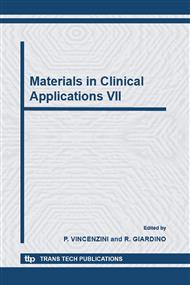p.246
p.252
p.258
p.263
p.269
p.275
p.282
p.290
p.300
Successful Development of Artificial Dental Root of the Gompholic System by Means of Bioceramics
Abstract:
The conventional concept of dental implants completely lacks odontology. Therefore, the dental implant system is quite different from the gompholic mammalian tooth system. Developmental research on artificial dental roots of the mammalian gompholic system has been carried out by the author successfully for the first time in the world from the viewpoint of odontology. Characteristics of the mammalian tooth system are gompholic and heterodontia with tribosphenic tritubercular molars. The meaning of heterodontia in morphology, i.e., several variations in crown and root shapes in different sites of mammalian jawbones are optimal shapes according to the different tooth functions, i.e., sphenic incisors and canines, and tribosphenic-tritubercular molars. For the optimal shapes of teeth adapted to their functions, the gompholic joint system is inevitable, i.e., fibrous articulation with cementoblasts, ligaments with capillaries, and the alveolar bone proper (socket bone). From this viewpoint, the author has developed artificial dental roots of the heterodontia gompholic system. Integrated research on animal experiments, biomechanical research as well as clinical research, have been carried out. It has been proved by microanalyses, microscopy, and scanning electromicroscopy (SEM) that cementoblasts, the cementum, periodontal ligaments, and the alveolar bone proper (socket bone), develop around artificial roots.
Info:
Periodical:
Pages:
290-299
Citation:
Online since:
October 2006
Authors:
Price:
Сopyright:
© 2006 Trans Tech Publications Ltd. All Rights Reserved
Share:
Citation:


